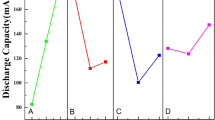Abstract
The synthesis process of LiCoO2 prepared by l-apple acid (l-HOOCCH(OH)CH2COOH) assisted sol–gel method is studied by using Fourier transforms infrared spectroscopy, mass spectroscopy, simultaneous thermogravimetric and differential thermal analysis, X-ray diffraction analysis, and elemental analysis. The results show that lithium and cobalt ions are trapped homogeneously on an atomic scale throughout the precursor. Lithium carbonate and Co3O4 are intermediate products during heat treatment of the precursor. Moreover, the kinetics for formation of LiCoO2 by l-apple acid assisted sol–gel method is faster than the case of the conventional solid-state reaction between lithium carbonate and Co3O4. In comparison with the solid-state reaction, the sol–gel method significantly shortens the required reaction time for synthesizing LiCoO2, and also reduces the particle size. In the electrochemical test, it is found that the specific discharge/charge capacities as well as the coulomb efficiency substantially increase with increasing the calcination temperature. It is considered that LiCoO2 with a good-layered structure facilitates the insertion and de-insertion of lithium ions in aqueous electrolyte. As a result, the combination of the sol–gel method with proper calcination processes is highly successful in producing LiCoO2 powders with large specific capacity and good cycle performance in aqueous lithium-ion battery.








Similar content being viewed by others

References
Beck F, Ruetschi P (2000) Electrochim Acta 52:2467–2482
Wang P, Yang H, Yang H (1996) J Power Sources 63:275–278
Kohler J, Makihara H, Uegaito H, Inoue H, Toki M (2000) Electrochim Acta 46:59–65
Wang G, Fu L, Zhao N, Yang L, Wu Y, Wu H (2007) Angew Chem Int Ed 46:295–297
Wang GJ, Zhao NH, Yang LC, Wu YP, Wu HQ, Holze R (2007) Electrochim Acta 52:4911–4915
Wang Y, Luo J, Wang C, Xia Y (2006) J Electrochem Soc 153:A1425–A1431
Ruffo R, Wessells C, Huggins RA, Cui Y (2009) Electrochem Commun 11:247–249
Lunblad A, Bergman B (1997) Solid State Ionics 96:173–181
Jeong ED, Won MS, Shim YB (1998) J Power Sources 70:70–77
Kumta PN, Gallet D, Waghray A, Bolmgren GE, Setter MP (1998) J Power Sources 72:91–98
Rho YH, Kanamura K, Fujisaki M, Hamagami J, Suda S, Umegaki T (2002) Solid State Ionics 151:151–157
Lala S, Montoro L, Donato E, Rosolen J (2003) J Power Sources 114:127–132
Castro-Garcia S, Castro-Couceiro A, Senaris-Rodriguez S, Soulette F, Julien C (2003) Solid State Ionics 156:15–26
Socrates G (1979) Infrared characteristic group frequencies. Wiley, New York
Geoffrey AL (2009) Introduction to coordination chemistry. Wiley, New York
Paul G (2008) Principles and applications of thermal analysis. Blackwell, London
Kim J, Fulmer P, Manthiram A (1999) Mater Res Bull 34:571–579
Tong DG, Luo YY, He Y, Ji XY, Cao JL, Tang LX, Tang AD, Huang KL, Lai QY (2006) Materials Science and Engineering B 128:220–228
Lumalai E, Vasan HN, Munichandraiah N (2005) J Power Sources 125:77–84
Tong DG, Lai QY, Lu JZ, Wei NN, Ji XY (2005) Chin Sci Bull 50:1087–1093
Cha QX (2002) Kinetics of electrode. Science Press, Beijing
Acknowledgments
This work was supported by Research Funds of CDUT (2007-YG2 and HZ0033), and the Natural Science Foundation of Sichuan Province (07ZA004). The authors would like to thank Engineer K.Y. Zhang for his assistance in the electrochemical performance test.
Author information
Authors and Affiliations
Corresponding author
Rights and permissions
About this article
Cite this article
Zeng, X.L., Huang, Y.Y., Luo, F.L. et al. Synthesis of LiCoO2 by l-apple acid assisted sol–gel method and its electrochemical behavior in aqueous lithium-ion battery. J Sol-Gel Sci Technol 54, 139–146 (2010). https://doi.org/10.1007/s10971-010-2168-y
Received:
Accepted:
Published:
Issue Date:
DOI: https://doi.org/10.1007/s10971-010-2168-y



